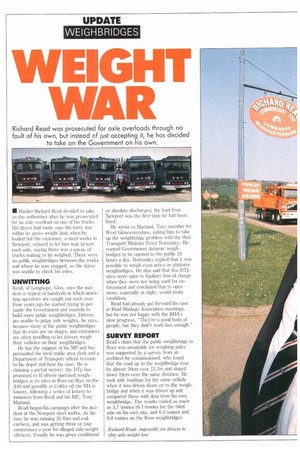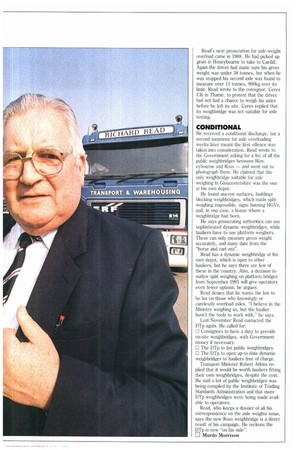WEIGH1
Page 46

Page 47

If you've noticed an error in this article please click here to report it so we can fix it.
Richard Read was prosecuted for axle overloads through no fault of his own, but instead of just accepting it, he has decided to take on the Government on his own.
• Haulier Richard Read decided to take on the authorities after he was prosecuted for an axle overload on one of his trucks. His driver had made sure the lorry was within its gross weight limit when he loaded but the customer, a steel works in Newport, refused to let him wait to test each axle, saying there was a queue of trucks waiting to be weighed. There were no public weighbridges between the works and where he was stopped, so the driver was unable to check his axles.
UNWITTING
Read, of Longhope, Glos, says the incident is typical of hundreds in which unwitting operators are caught out each year. Four years ago he started trying to persuade the Government and councils to build more public weighbridges. Drivers are unable to judge axle weights, he says, because many of the public weighbridges that do exist are on slopes, and customers are often unwilling to let drivers weigh their vehicles on their weighbridges.
He has the support of his MP and has persuaded the local traffic area clerk and a Department of Transport official to come to his depot and hear his case. He is claiming a partial victory: the DTp has promised to fit driver-operated weighbridges at its sites in Ross-on-Wye on the A40 and possibly at Coldra off the M4 in Gwent, following a series of letters to ministers from Read and his MP, Tony Marland.
Read began his campaign after the incident at the Newport steel works. At the time he was running 35 flats and coilcarriers, and was getting three or four summonses a year for alleged axle-weight offences. Usually he was given conditional or absolute discharges; the load from Newport was the first time he had been fined.
He wrote to Marland, Tory member for West Gloucestershire, asking him to take up the weighbridge problem with the then Transport Minister Peter Bottomley. He wanted Government dynamic weighbridges to be opened to the public 24 hours a day. Bottomley replied that it was possible to weigh even artics on platform weighbridges. He also said that five DTp sites were open to hauliers free of charge when they were not being used for enforcement and concluded that to open more, especially at night, would invite vandalism.
Read had already put forward his case at Road Haulage Association meetings, but he was not happy with the RHA's slow progress. 'They're a good body of people, but they didn't work fast enough."
SURVEY REPORT
Reads claim that. the public weighbridge in Ross was unsuitable for weighing axles was supported by a survey from an architect he commissioned, who found that the road up to the weighbridge rose by almost 50cm over 12.2m and sloped down 19cm over the same distance. He took axle readings for the same vehicle when it was driven down on to the weighbridge and when it was driven up and compared these with data from his own weighbridge, The results varied as much as 3.7 tonnes (6.1 tonnes for the third axle on his own site, and 6.0 tonnes and 9.8 tonnes on the Ross weighbridge).
Richard Read: impossible for drivers to obey axle weight law. Read's next prosecution for axle-weight overload came in 1988. He had picked up grain in Honeybourne to take to Cardiff. Again the driver had made sure his gross weight was under 38 tonnes, but when he was stopped his second axle was found to measure over 11 tonnes, 900kg over its limit. Read wrote to the consignor, Ceres UK in Thame, to protest that the driver had not had a chance to weigh his axles before he left its site. Ceres replied that its weighbridge was not suitable for axle testing.
CONDITIONAL
lie received a conditional discharge, but a second summons for axle overloading weeks later meant the first offence was taken into consideration. Read wrote to the Government asking for a list of all the public weighbridges between Honeybourne and Ross — and went out to photograph them. He claimed that the only weighbridge suitable for axle weighing in Gloucestershire was the one at his own depot.
He found uneven surfaces, buildings blocking weighbridges, which made splitweighing impossible, signs banning HGVs, and, in one case, a house where a weighbridge had been.
He says prosecuting authorities can use sophisticated dynamic weighbridges, while hauliers have to use platform weighers. These can only measure gross weight accurately, and many date from the "horse and cart era".
Read has a dynamic weighbridge at his own depot, which is open to other hauliers, but he says there are few of these in the country. Also, a decision to outlaw split weighing on platform bridges from September 1991 will give operators even fewer options, he argues.
Read denies that he wants the law to be lax on those who knowingly or carelessly overload axles. "I believe in the Ministry weighing us, but the haulier hasn't the tools to work with," he says.
Last November Read contacted the DTp again. He called for:
o Consignors to have a duty to provide on-site weighbridges, with Government money if necessary.
0 The DTp to list public weighbridges. 0 The Dip to open up-to-date dynamic weighbridges to hauliers free of charge.
Transport Minister Robert Atkins replied that it would be worth hauliers fitting their own weighbridges, despite the cost. He said a list of public weighbridges was being compiled by the Institute of Trading Standards Administration and that more DTp weighbridges were being made available to operators.
Read, who keeps a dossier of all his correspondence on the axle weights issue, says the new Ross weighbridge is a direct result of his campaign. He reckons the DTp is now "on his side".
LI Murdo Morrison




































































































































